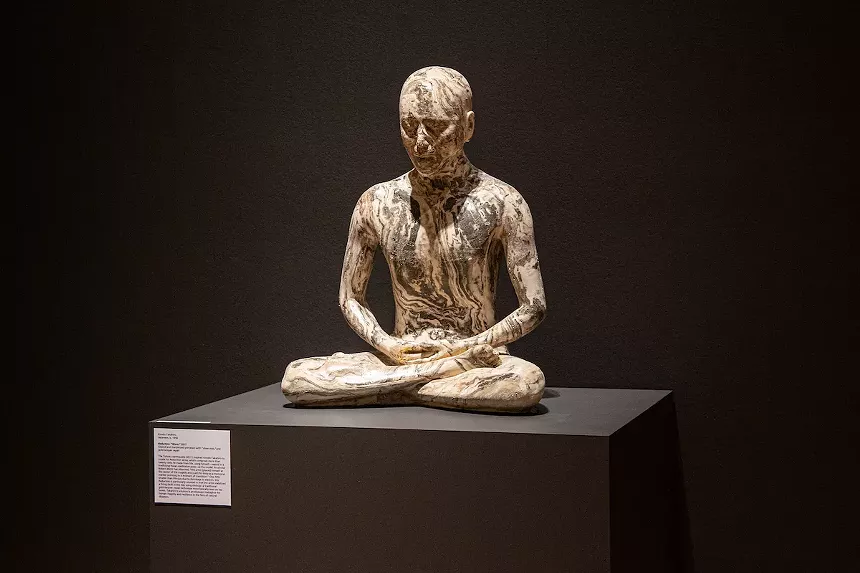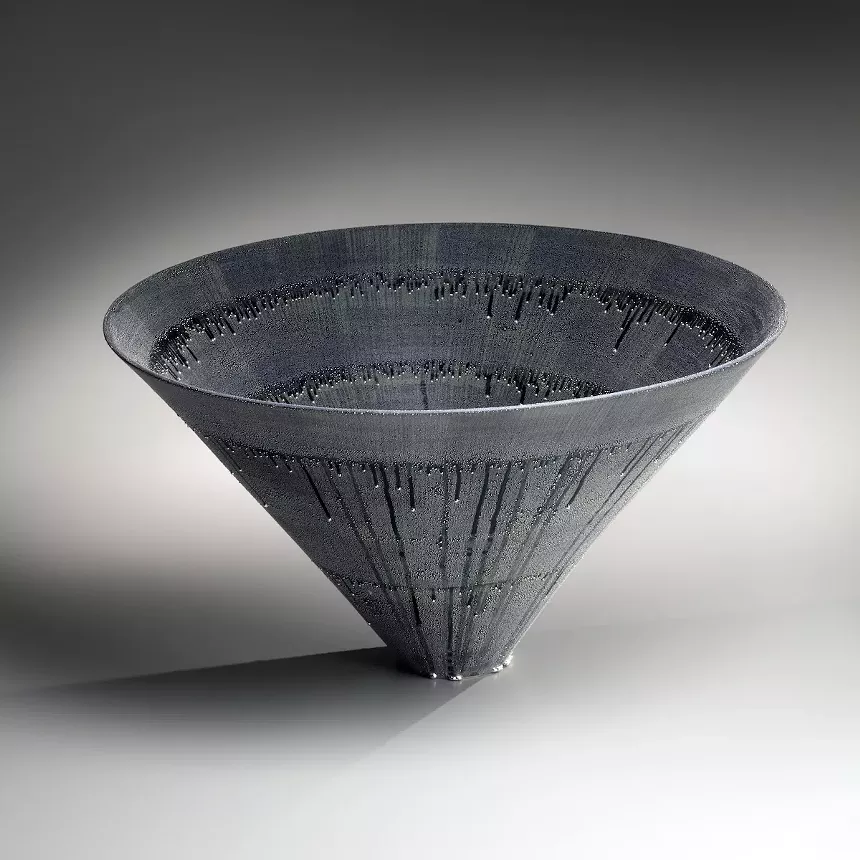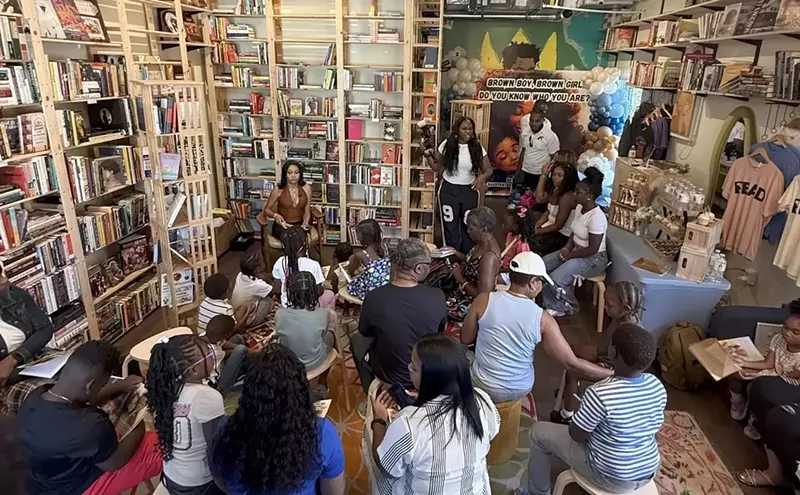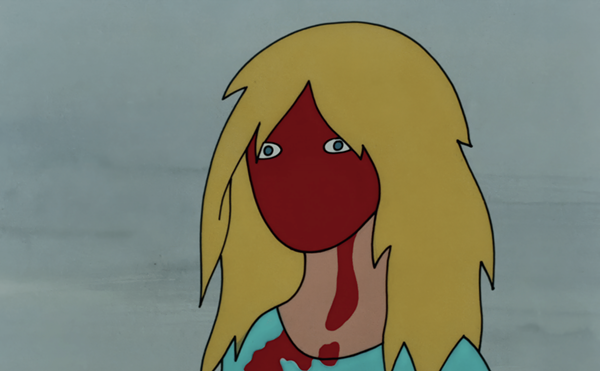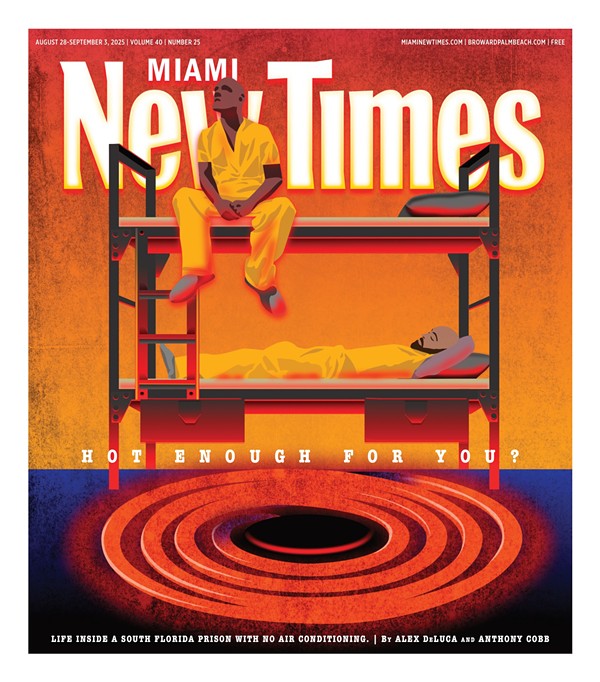Out of all of Japanese pottery master Kondo Takahiro's works, the ones that came after the largest earthquake in his country's history feel particularly resonant.
As the disaster became known, 3/11 marked Japan's largest loss of life since World War II, with nearly 20,000 dead and thousands more displaced. The chain reaction caused by the tremor on March 11, 2011, included a massive tsunami, a nuclear meltdown at the Fukushima Daiichi power plant, and the largest radioactive exclusion zone since Chernobyl.
As the country reckoned with the consequences of its use of nuclear power, Kondo reckoned with the disaster through his artistry, beginning his "Reduction" series that same year. He created 20 full-body casts of his likeness seated in Zen meditation. One of these statues forms the centerpiece of the Lowe Art Museum's latest exhibition, "Transcendent Clay – Kondo: A Century of Japanese Ceramic Art."
One-fifth the size of the artist himself, the statue, made of porcelain with a marbled exterior and covered in fine silver beads, also features an unusual gold embellishment. After breaking in the kiln, Kondo fixed the sculpture with kintsugi, the traditional, somewhat trendy pottery repair technique that uses gold-dusted lacquer to repair broken pottery.
Joe Earle, a guest curator at the Lowe Art Museum at the University of Miami, believes the kintsugi to be the defining aspect of the piece, saying it "gives marvelous emphasis to the whole point of the work, this notion of fragility, breakability — it reminds us to be mindful of our place in the universe." It also forms a powerful metaphor for Japan's recovery from 3/11. Kondo's likeness is covered with brown and black streaks as if recently buried in the earth, yet its pose remains solemn and strong, the damage repaired and the scars left as a memento of history.
Of course, if there is any focus on history in the show, it is that of the Kondo family itself, which over three generations has developed, refined, and revolutionized Japanese porcelain art. Four members of the family are represented in the show: Takahiro (born 1958), his father Hiroshi (1936-2012), uncle Yutaka (1932-1983), and grandfather Yuzo (1902-1985), who was named a Living National Treasure by the Japanese government in 1977.
Descended from a samurai family in the ancient capital of Kyoto, also a significant center for porcelain production, Yuzo's decision to train in ceramic arts set the family down its fateful path. After apprenticing under the influential artist Tomimoto Kenkichi, Yuzo set up his studio near the famous Kiyomizu-dera temple in Kyoto. He became a master of sometsuke, a blue-and-white porcelain style brought from Asia by Korean artisans in the 17th century.
In the 1950s, he began to add multicolor pigments. Some of the most distinctive works in the show are marvelous porcelain vessels from the '70s and '80s that incorporate brilliant reds and golds with natural motifs such as mountains, pomegranates, and bamboo. His sons both followed in his footsteps and became ceramicists, but while Hiroshi continued the blue-and-white style of his father, his elder son Yutaka broke with tradition. He traveled widely and became particularly fascinated by buncheong, a stamped stoneware style from Korea.
His works in the exhibition show its influence, and they appear both ancient and modern, with dark colors and patterned markings that evoke some lost, perhaps even alien, civilization.
Then came Takahiro. Yuzo's grandson had never intended to join the family business; his original career path was table tennis, another discipline requiring quick reaction time. However, Yutaka's early death in 1983 changed things, and Takahiro adopted his uncle's iconoclasm. First, he experimented with metal glaze, resulting in an iconic, patented technique called ginteki (silver mist), where tiny beads of metal form on the exterior of a piece of porcelain. Utterly dazzling, with some ginteki patterns resembling galaxies or pearls, these pieces feel especially appropriate for glitzy Miami; they also run contrary to the earthy imperfection that traditionally marks Japanese pottery.
It was to that earthiness that Takahiro would eventually return. Throughout his career, he had experimented with dozens of new techniques and forms, pushing ceramic art beyond the confines of the vessel, beyond the need for works made of clay to have a practical use as a bowl or flower pot, and created sculptures that exist primarily as works of contemporary art. He began to incorporate materials such as glass and created abstract forms that broke with the Kondo tradition of representation.
A visit to the Ring of Brodgar in Scotland inspired his "Monoliths" series, creating zigzagging standing sculptures of porcelain and glass. Eventually, he began to create self-portraits, incorporating his entire arsenal of techniques in a series of slip-casted statues of his head titled "Reflection."
But 3/11 caused Takahiro to shift his priorities. He began volunteering in Tohoku, his wife's home region, to aid in its recovery from the disaster. He began to work actively there, creating raw, ash-glazed stoneware from local materials. For his "Vessels for Life" project in 2011, he created nearly 2,000 simple, beautiful bowls made of local clay to give to earthquake victims.
These are perhaps the most moving pieces in the exhibition because, unlike Takahiro's "Reduction," they do not center the artist's ego. Instead, they represent the idea that all people deserve access to great art, even in the darkest times, and that the sublime can be found even in the humblest clay bowl.
– Douglas Markowitz, ArtburstMiami.com
"Transcendent Clay – Kondo: A Century of Japanese Ceramic Art." Through September 24 at Lowe Art Museum at the University of Miami, 1301 Stanford Dr., Coral Gables; 305-284-3535; lowe.miami.edu. Admission is free. Wednesday through Saturday 10 a.m. to 4 p.m.

Audio By Carbonatix
[
{
"name": "GPT - Billboard - Slot Inline - Content - Labeled - No Desktop",
"component": "22004575",
"insertPoint": "2",
"requiredCountToDisplay": "2"
},{
"name": "STN Player - Float - Mobile Only ",
"component": "22595215",
"insertPoint": "2",
"requiredCountToDisplay": "2"
},{
"name": "Editor Picks",
"component": "17482312",
"insertPoint": "4",
"requiredCountToDisplay": "1"
},{
"name": "Inline Links",
"component": "18711090",
"insertPoint": "8th",
"startingPoint": 8,
"requiredCountToDisplay": "7",
"maxInsertions": 25
},{
"name": "GPT - 2x Rectangles Desktop, Tower on Mobile - Labeled",
"component": "23181625",
"insertPoint": "8th",
"startingPoint": 8,
"requiredCountToDisplay": "7",
"maxInsertions": 25
},{
"name": "Inline Links",
"component": "18711090",
"insertPoint": "8th",
"startingPoint": 12,
"requiredCountToDisplay": "11",
"maxInsertions": 25
},{
"name": "GPT - Leaderboard to Tower - Slot Auto-select - Labeled",
"component": "17720761",
"insertPoint": "8th",
"startingPoint": 12,
"requiredCountToDisplay": "11",
"maxInsertions": 25
}
]


